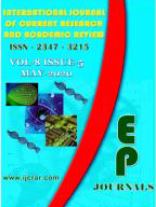Abstract Volume:8 Issue-5 Year-2020 Original Research Articles
 |
Online ISSN : 2347 - 3215 Issues : 12 per year Publisher : Excellent Publishers Email : editorijcret@gmail.com |
The rising demand for renewable energy sources induced the development of new technologies to produce bioethanol. In this research work, commonly available large volume-fruit peels (Banana, Mango and Papaya) were investigated for bio-ethanol production via fermentation by yeast, Saccharomyces cerevisiae. The fruit peels were crushed and mashed to a fine powder (0.40 mm).The optimized hydrolysis conditions are 10 % biomass/substrate load, 1 % H2SO4, 98 oC hydrolysis temperature and 24 hours of hydrolysis time. The optimized fermentations conditions are pH(5.0-5.5), 30 oC of fermentation temperature, 72 hours of fermentation time and 2 g/L of yeast load. The highest purity of the bioethanol obtained for each fruit (Mango, Papaya and Banana) peel was 95.05 %, 96.11 % and 95.49 % respectively. Findings from this research work suggest that fruit peel wastes like Mango, Papaya and Banana can be used to produce bioethanol rather than discarding in to environment. The work also proved that the waste product of fermentation may be used as animal feedstock or fertilizer to enrich the soil for plant growth.
How to cite this article:
Abambagade Abera Mitiku and Tanje Mada Hatsa. 2020. Bioethanol Production from Decaying Fruits Peel Using Saccharomyces cerevisiae.Int.J.Curr.Res.Aca.Rev. 8(5): 50-59doi: https://doi.org/10.20546/ijcrar.2020.805.006



Quick Navigation
- Print Article
- Full Text PDF
- How to Cite this Article
- on Google
- on Google Scholor
- Citation Alert By Google Scholar
